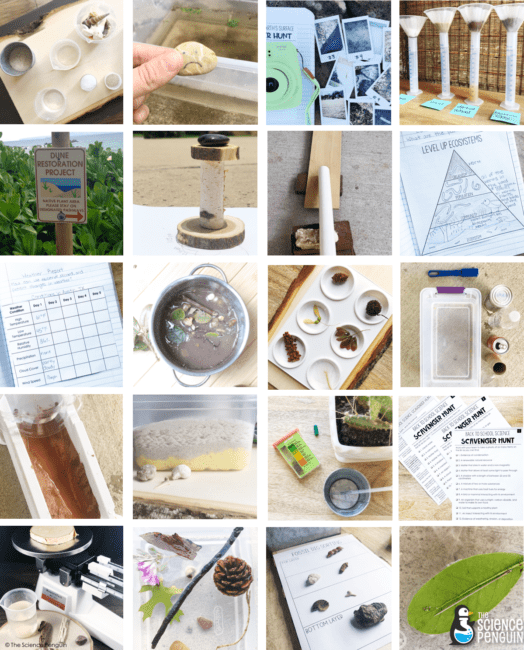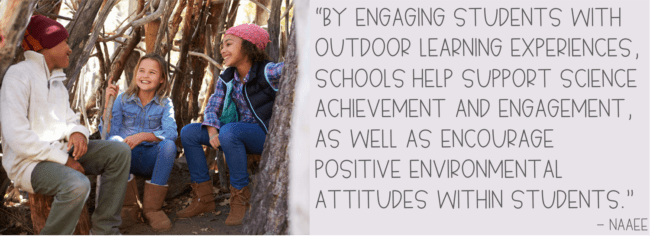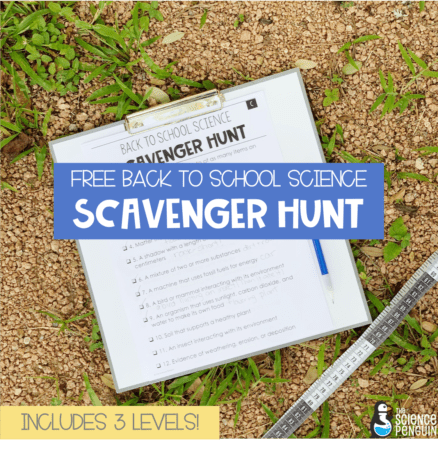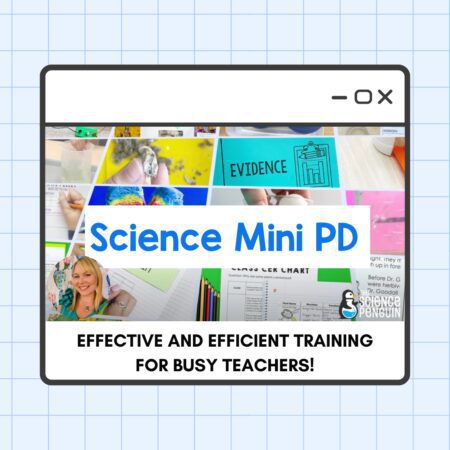
My daughter’s eagerness to explore her world, her love of sticks and leaves, and the creativity she shows when working with natural materials has inspired me as an educator. When I thought back to all of my successful outdoor lessons in upper elementary, I committed to outdoor teaching with my science groups at least twenty percent of the time.

What I have learned is that we can easily do more to incorporate memorable science experiences on a regular basis right at school.
5 Reasons to Teach Science Outside
1. You can do this anywhere.
Whether or not a school has access to a natural utopia right outside the doors, we can provide students with opportunities to be outdoors or work with natural materials in the classroom.
If you can’t make it outside, bring the outdoors in with materials found in nature.
“Outdoor education opportunities should be a priority in education. Schools should provide access to outdoor settings on school property and teachers should integrate outdoor experiences into traditional curricula as a means to enhance science learning. By engaging students with outdoor learning experiences, schools help support science achievement and engagement, as well as encourage positive environmental attitudes within students. Schoolyards are often effective places for outdoor learning experiences. Practical means with which to enhance schoolyard learning experiences include building school gardens, constructing bird feeders, and incorporating native plants.” (The Promise of Outdoor Education in School)

2. It’s cheap.
Using natural materials requires no access to expensive programs or devices. Go for a walk and pick up what you find, take a trip to the craft store, or shop in bulk on Amazon.
I recommend that you ask friends, family, and other teachers from different locations to send you seeds, pinecones, sticks, soil, rocks, shells, and other items native to their environments.
3. It’s {often} low prep.
A lesson outside might be more intricate and require more prep, but it often requires no prep at all.
Focused nature walks, scavenger hunts, and observations can be planned and prepped in just a few minutes, especially with ready-to-use, standards-based science activities.

4. Being outside is good for kids.
Lessons that take place outside can benefit students’ mental health and improve behavior.

A NOTE ON TECHNOLOGY: While I love what technology has done for our world and education, Technology is just one-fifth of STEAM (Science, Technology, Engineering, Art, and Mathematics.)
We cannot forget the importance of other core subject areas, the nurturing of soft skills, and the development of logical and creative thinking skills. Encourage students to explore their environments with paper, pencil, and interpersonal communication.
Students spend so much time looking at screens. I encourage you to incorporate technology outside to document scientific observations, to communicate with others around the world, and to create something new.

5. You can help students move mountains.
Nicolette Sowder said, “If we want our children to move mountains, we first have to get them out of their chairs.” Outdoor learning is important. You have the power to change the world.
I’m here to connect standards-based learning with engagement and to connect college and career readiness with the natural world.
Let’s remember that experiences are more memorable than worksheets.
Let’s take risks and try something new.
Let’s consider the opportunities to teach our students the standards using what nature provided.
Let’s teach students how to collaborate, protect nature, and keep themselves safe outdoors.
Let’s make the world our classroom.

It’s likely you are reading this post because:
- You are ready for more.
- You want to challenge your students and yourself.
- You want to teach real-world, standards-based science.
- You understand the value of time spent outdoors.
- You want to make a difference in the world.
We can build on the sense of wonder children are all born with.
Free Back to School Science Scavenger Hunt
Would you like to start the year with an outdoor science lesson? Download the preview on TpT for this free resource!
If you like the scavenger hunt, you will love my newest full resource! Out the Door to Explore: Full STEAM Ahead, is packed full of ideas to help you get started or take your instruction one step further.
Let me show you more!
What is Included?
- 35 science activities
- 2 bonus scavenger hunts
- TEKS alignment information
- NGSS alignment information
- materials lists
- suggestions and directions
- discussion questions
- notebook ideas
- photographs and examples
- optional printables










5 thoughts on “Out the Door to Explore: 5 Reasons to Teach Science Outside”
Thanks. I like it
Wow! That is some list. I love learning and trying new things so this will be a staple in our household. Thanks for sharing!
Honestly couldn’t agree with you more about this. There are just so many reasons for kids to go outside to learn stuff that just can’t happen in the classroom!
I completely agree with you, being outside is very healthy for kids. I love your ideas how you can make kids learn using outdoor environment. I would love to share this post. Thanks for sharing this informative post.